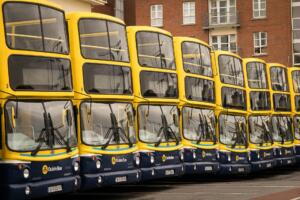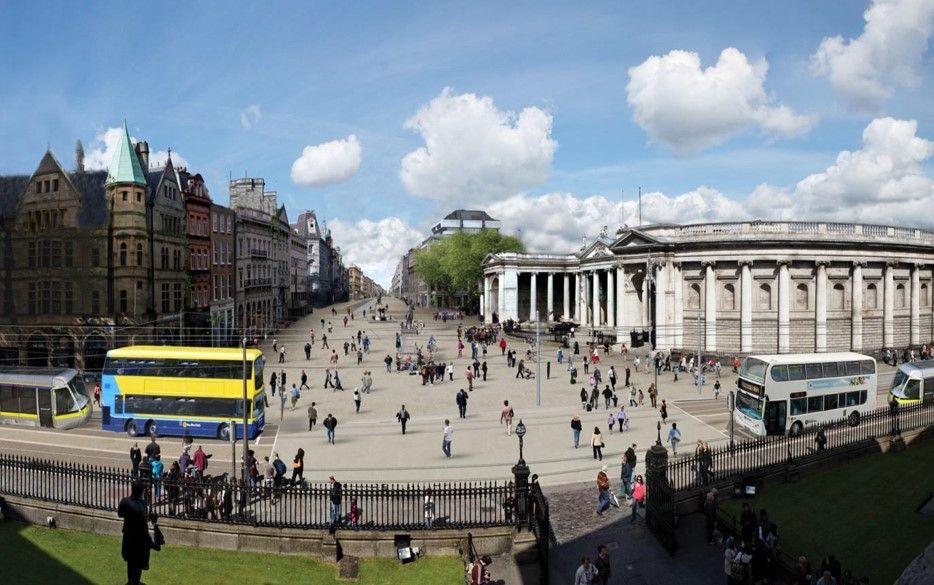Sign Language: Dublin revitalises wayfinding
What happens when a city’s road signs are no longer fit for purpose? Colm Ennis examines POLIS member, Dublin City’s endeavour to replace over 300 bilingual signs on its Inner and Outer Orbital Routes, tracing the process from consultation to delivery.
In the early 2000s, Dublin City Council created Inner and Outer Orbital Routes, with associated signage to assist wayfinding around the city centre and its outskirts. The economic boom at that time was generating more traffic and the Orbital Routes were designed to redirect cross-city traffic away from the busy city centre.
During this period Dublin was also drastically improving its transport infrastructure. New metro lines (named Luas, the Irish word for ‘speed’), a port access tunnel, several bridges over Dublin’s river Liffey (including the iconic Calatrava-designed Samuel Beckett Bridge), additional cycling infrastructure and a better bus transport provision were made available to enhance the accessibility and service delivery of transport in the city.

13 Christchurch Pl, Wood Quay, Dublin, Ireland, © Lucas Miguel via Unsplash
Yet, with the population approaching 600,000 in the city and 1.8 million in Greater Dublin, all combined with a growing economy, by the mid-2000s high traffic volumes on the city’s streets had grown and, unsurprisingly, the signage erected alongside the orbital routes were losing their relevance and needed to be refreshed. Signs no longer reflected urban traffic flows: it became necessary to review and update them to reflect the wave of changes in Dublin’s now more expansive and integrated transportation system.
Sign re-design: the consultation process
Dublin City Council and Ireland’s National Transport Authority (NTA) initiated a project to develop a new signage scheme for the Inner and Outer Orbital Routes in 2017. The aim was to update the signage, make it easier to understand it and thus improve access to off street cycle parking and city centre car parks.
The National Transport Authority (NTA) is the transport authority for the Greater Dublin Area and the public transport licensing agency for Ireland. The NTA is involved in the supply and contracting out of public transport services, including Public Service Obligation (PSO) contracts – Iarnród Éireann, Dublin Bus, Go-Ahead Ireland, Bus Éireann, as well as subcontracting with the Luas service.
The task of re-designing the Orbital Route signage scheme was awarded to Arup. The new signs would have to comply with the statutory requirements for road and traffic signage, set out in the Traffic Signs Manual. As Ireland is officially a bilingual country, the new signage design would need to include both Irish and English texts. As many cities across Europe know only too well, harmonising language differences is incredibly important: all those involved in Dublin’s efforts were keen to adhere to the mission in both spirit and (physical and metaphysical) letter . It was a process of exploration and reflection. Consideration was given to other similar signage schemes from Ireland, Europe and further afield, examining which designs had been successful, and how elements of these could be replicated for use in Dublin. A number of designs were proposed, following the principles of clarity, concision, consistency, comprehension, flexibility and sustainability.

New Orbital Routes, © Dublin City Council
The chosen design was then presented to both internal and external stakeholders at a consultation event at Dublin City Council. Invitees came from internal departments, business representative groups, City councils, car parks, cycling groups, delivery providers organisations and tourism sector. In addition, a small focus group of people living outside of Dublin and regularly commuting to the capital were consulted. Feedback from the consultation revealed that these first draft signs were still difficult to understand and remained too complicated to follow. The design team returned to the drawing board and arrived at a simpler design, which was presented again to stakeholders. With a few more tweaks, Dublin finally found their perfect signage recipe.
With over 550 accredited engineers and staff across four offices, ARUP is one of the largest engineering consulting firms in Ireland. The company has been involved in a range of projects which have helped to shape Dublin’s transportation networks, including Terminal 2 at Dublin Airport, the M50 motorway, Swords BRT Scheme and the Tallaght and Clondalkin Movement Framework Plans.
Contract and communication
Next up was a procurement process (prescribed for public sector works in Ireland) and Cairn Construction was awarded the project to supply and erect the new signs in a contractor-led, rather than sign manufacturer-led tender. Before rolling out the new Orbital Route signs, a communications strategy was developed. This included information posted on the city council website and a comprehensive list of questions and answers to help explain the scheme and gain public support. Sign manufacture and checking took place in late 2019 and work on the ground began in January 2020. By March 2020 over 300 new signs had been erected using existing poles as well as 100 new ones, and existing signs that were no longer required were removed.
So, what did Dublin learn?
This project revealed several important aspects for sign replacement processes in Ireland and, possibly, in other cities and regions across Europe.

Dublin tram (also known as Luas) to Tallaght/Tamhlacht, largest settlement and county town of South Dublin and largest satellite town of Dublin, © Louis Hansel via Unsplash
Consultation is key
Engaging multiple times with key groups of internal and external stakeholders led to the development of a more broadly accepted scheme design. In a world where travel is determined by satellite navigation and online wayfinding, is static signage needed any longer? In brief, yes it is. The consultation process indeed proved the enduring relevancy of physical signage: it revealed road users still desire this infrastructure, and they particularly do so when they do not use digital wayfinding technologies.
National signage design regulations and manuals are important
National signage design regulations and manuals allow for flexibility and consistency. More traditional signage and wayfinding measures support road users by providing information on objective or subjective optimal routes for any trip purpose and are still very much relevant even with an increase of digital integrations. They can increase the level of road awareness and give a clear, easy, and recognizable solution to the challenges that the layout of city centre roads may present.
Teamwork makes the dream work

Dublin buses, © Pixabay
Dublin’s success depended on close cooperation between a number of parties. This cooperation showed what can be achieved through good leadership, competent designers and a flexible, ‘can do’ approach from all those involved. While the scheme was being finalised, the lives of all stakeholders were being turned upside down by COVID-19, yet everyone was able to see the project to completion.
HOT or NOT, updated signage means A LOT
Dublin’s new signage scheme will help to cement the improvements in the city’s integrated transportation system. As automated vehicular, electric charging and speed assistance technology continues to transform car use and the ways travellers navigate our cities and regions, Dublin’s case showed us that local authorities must continue to revise and update signage accordingly. It may not be the hottest topic in town, but it is one of the most important.
Dublin City Council is the authority responsible for local government in the Irish capital. The council is responsible for housing and community, roads and transportation, urban planning and development, amenity and culture and environment.
About the author:
Colm Ennis is Senior Executive Engineer at the Environment & Transportation Department of Dublin City Council, colm.ennis@dublincity.ie
 Proposed College Green Plaza, © Dublin City Council
Proposed College Green Plaza, © Dublin City Council